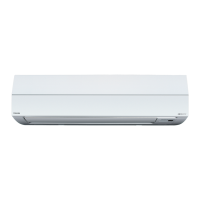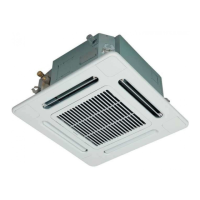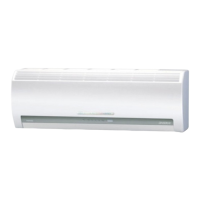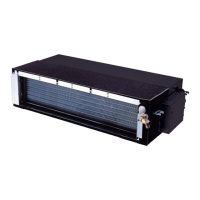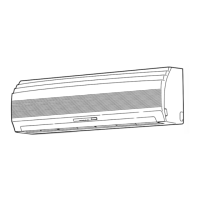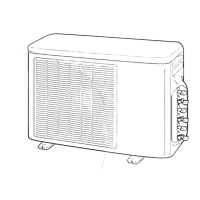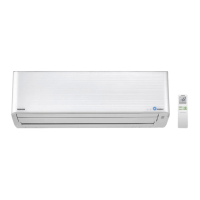
Do you have a question about the Toshiba RAS-M10SKCV-E and is the answer not in the manual?
| Brand | Toshiba |
|---|---|
| Model | RAS-M10SKCV-E |
| Category | Air Conditioner |
| Language | English |
Precautions for R410A refrigerant installation to avoid impurities.
Requirement for circuit breaker/switch for disconnection.
Warning about high voltage circuits and touching P.C. boards.
Covers safety guards, weight, leaks, electrician, wiring, grounding.
Covers water exposure, vibration, sharp edges, earthquakes.
Lists outdoor units compatible with indoor units.
Details specifications for indoor units like dimensions, weight, noise.
Details specifications for outdoor units like dimensions, weight, motor output.
Details power supply and interconnection wiring.
Lists included accessories.
Safety precautions when handling R410A refrigerant.
Specifies piping materials and installation.
Details copper pipe specifications and joints.
Procedures for cutting, deburring, and flaring pipes.
Procedures and dimensions for flare processing.
Tables for flare and flare nut dimensions for R410A and R22.
Steps and precautions for connecting flares, including torque.
Lists exclusive and general tools for R410A installation.
Types of brazing filler materials.
Reason for flux use and its characteristics.
Procedures for brazing, including preventing oxidation.
Table showing compatible brazing materials.
Block diagram of the indoor unit's control system and functions.
Overview of the air conditioner's control system and roles.
Covers general operation control and modes.
How modes are selected in multi-room operation.
How cooling and heating operations are controlled.
Automatic mode selection based on room temperature.
Dehumidification mode operation.
Fan speed control in cooling and heating modes.
Adjustment of cooling/heating capacity via compressor revolution.
Protection control based on indoor heat exchanger temperature.
Control of air direction via louvers.
Energy-saving operation mode.
How to perform temporary AUTO or COOL operation.
Function to clean the indoor unit and prevent mold.
How to cancel or set the Self-Cleaning function.
Setting remote control for single unit operation.
Operation for reduced noise level.
Sleep mode for energy saving and comfort.
Timer function for testing or trial operation.
Automated operation for preferred regional conditions.
Mode for faster cooling or heating.
Indicator for filter cleaning and how to turn it off.
Procedure to enable the auto restart function.
Procedure to disable the auto restart function.
How timer operation is affected by power failure.
Identification of remote control buttons and their purposes.
How to use various remote control modes like ONE-TOUCH, AUTO, COOL/HEAT.
Instructions for Dry mode operation.
How to activate Hi-POWER mode.
How to activate ECO energy-saving mode.
Setting ON and OFF timers, and Everyday Timer.
Setting and operating preset preferences.
Setting and canceling the auto restart function.
How to operate in quiet mode.
Sleep mode for energy saving and comfort.
Explains indicators and symbols on the remote display.
Visual guide for indoor and outdoor unit placement and piping.
Criteria for selecting the indoor unit installation location.
Steps for drilling holes and mounting the installation plate.
Procedures for securely mounting the installation plate on the wall.
Requirements for connecting the power supply.
How to connect the connecting cable to the indoor unit.
Cutting slots in the front panel for piping.
Relocating the drain hose and cap.
Procedure for attaching the drain cap.
Connecting pipes from the left side, including bending radius.
Cutting front panel slits for right/left piping.
Steps for hanging and securing the indoor unit on the installation plate.
Initial checks for power supply and voltage.
Interpreting LED flashing codes for self-diagnosis.
Steps to enter service mode and read error codes.
Diagnosing issues with the indoor unit and remote controller.
Troubleshooting steps for a non-operating indoor fan motor.
Diagnosing fan motor auto-rotation issue.
Troubleshooting when the outdoor unit is not operating.
Diagnosing why the outdoor unit stops after starting.
Procedures for inspecting the indoor unit's P.C. board.
Steps for disassembling and replacing indoor unit parts.
Procedure for removing and reassembling the front panel.
Procedure for removing and assembling the electric parts box.
Procedure for removing the horizontal louver.
Procedure for removing the heat exchanger.
Procedure for removing and replacing the bearing.
Procedure for removing the fan motor.
Caution and procedure for reassembling the cross flow fan.
Exploded view and part list for the indoor unit.
Exploded view and part list for the indoor unit.

